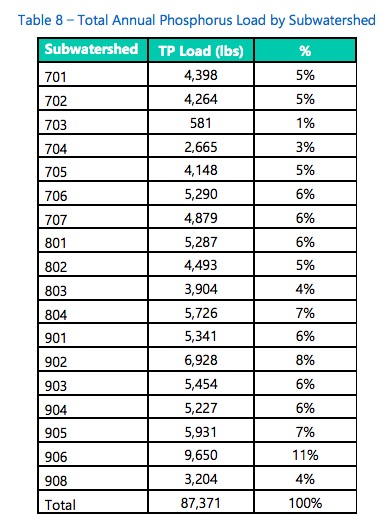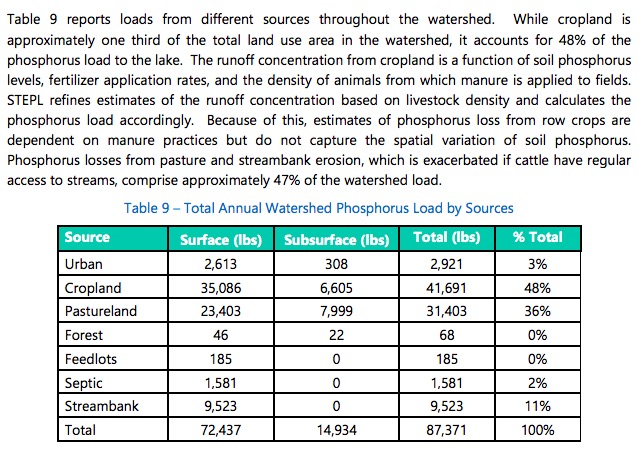Lake Mitchell, the 90-year-old reservoir north of Mitchell, is so full of algae that the city is considering draining the lake to remove the nutrient-laden silt from the lake bed. Unfortunately, the city learned last week that that project could be eight times harder than they thought:
Coring samples taken from Lake Mitchell in February revealed the volume of sediment laden with algae-producing phosphorus may be up to eight times what was earlier estimated, throwing a $7.2 million estimate for a lake cleanup project into question.
…The early estimates said about 250,000 cubic yards of the lake would need to be dredged, but preliminary information from the February study show the total is closer to 2 million cubic yards.
Not all of the sediment may need to be dredged, [lake consultant Mike] Sotak emphasized. The depth of the material containing phosphorus varies widely around the lake, and deep areas could be capped with clay and neutralizing alum to reduce algae blooms. Over the next eight weeks, [Soak’s firm Fyra Engineering] will examine cost options for dredging and capping [Mark Andersen, “Recent Lake Study Shows Additional Problems,” Mitchell Daily Republic, 2018.04.02].
Dredging and capping all the silt at the bottom of Lake Mitchell won’t make a lasting difference if nutrients keep flowing into the lake. In its January 2018 technical memorandum, Fyra Engineering reports that while 78,000 pounds of phosphorus originate in the lake, another 87,000 pounds of phosphorus pour into the lake from the extensive Lake Mitchell watershed each year:


Fyra breaks that phosphorus load down by source. Fitting with estimates I heard about algae-producing pollution back in Lake County, 84% comes from agricultural land:

Fyra Engineering estimates that a comprehensive watershed improvement strategy, including cover crops, conservation tillage, grazing management, fencing and alternative water sources, buffers, grassed waterways, watershed ponds, constructed wetlands, and pothole wetland restoration, could reduce phosphorous inputs by 50% and would cost $53 million (see p. 56).
Less expensive, natural alternative. Breach the dam. Allow the creek to re-establish its water course.
If they do not make a law to put fifty feet of grass next to the rivers to stop the phosphorous run off, they will not fix anything because it will come right back. Yes, the same phosphorous foam that killed a little girl by the falls in Sioux Falls. Farmers could better keep that phosphorous on their land and keep the topsoil from running into the river with a little grass.
Too bad no one in SD grows barley grass. It can prevent algae from growing in lakes. Oh well, we are so stupid.
https://extension.psu.edu/barley-straw-for-algae-control
chris, no one knows what barley grass is. If you mention the word “grass” in South Dakota, the feeble are gonna denounce it as something anti Biblical or on the same line.
since no one has said it yet, I’m pretty sure republicon sludge in SD is 8-10xs deeper than expected
If anyone brews beer in South Dakota, or even imbibes barley pop, you should know what barley is.
Mr. Elgersma, they do encourage such behaviors by reducing the taxes on such land. It was a law bill.
John makes a point worth remembering, if not acting on: Lake Mitchell exists only by human intervention. Water shouldn’t stopping there.
I wonder: could folks downstream make the argument that Lake Mitchell is sparing their watershed of increased phosphorus and other pollution… somewhat as Lake Herman serves as Lake Madison’s filtration pond? :-)
Lake Mitchell acts like a nutrient sink. Yes, it is an artificial wetland that more or less behaves like a natural wetland. Breeching the dam just sends all new sediment and non point source pollution further down stream and compromises more land and water. The study data is spot on. But don’t tell that to a politician that hates science because he’ll find a political solution that doesn’t work. Until the entire watershed above Lake Mitchell is secured from adding silt, runoff chemicals and other point source ag pollution, drain and dredge is nothing but a band aid that will come off, perhaps in as little as 10 years depending upon precipitation and freshet run off. No amount of buffer strip legislation along streams is going to stop the sedimentation and chemical run off. All that material enters tertiary and secondary water courses before they connect with primary streams that are either permanent or semi-permanent. The City of DeMoines, Iowa was suing the upstream counties for basically causing this same problem for DeMoines. We don’t have many responsible land stewards in South Dakota…………..
I should also mention that this condition is the expected result when we drain, fill or channelize natural wetlands that are better equipped and situated to deal with sequestering nutrients in run off. You remember that “prairie pothole” duck factory that we use to have? A lot of it is in Lake Mitchell and a lot more of it is tearing down the Big Sioux and into the Missouri River. It’s only a matter of time before Nebraska and Missouri and the down stream states are going to start complaining about that too.